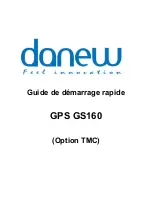
◦ Third-party CAT5 cable and RJ45 connectors must not be
used for Garmin Marine Network connections.
◦ Additional Garmin Marine Network cables and connectors
are available from your Garmin dealer.
• The NETWORK ports on the device each act as a network
switch. Any compatible device can be connected to any
NETWORK port to share data with all devices on the boat
connected by a Garmin Marine Network cable.
NMEA 2000
®
Considerations
NOTICE
If you have an existing NMEA 2000 network on your boat, it
should already be connected to power. Do not connect the
NMEA 2000 power cable to an existing NMEA 2000 network,
because only one power source should be connected to a
NMEA 2000 network.
If you are installing a NMEA 2000 power cable, you must
connect it to the boat ignition switch or through another in-line
switch. NMEA 2000 devices will drain your battery if the NMEA
2000 power cable is connected to the battery directly.
This device can connect to a NMEA 2000 network on your boat
to share data from NMEA 2000 compatible devices such as a
GPS antenna or a VHF radio. The included NMEA 2000 cables
and connectors allow you to connect the device to your existing
NMEA 2000 network. If you do not have an existing NMEA 2000
network you can create a basic one using cables from Garmin.
If you are unfamiliar with NMEA 2000, you should read the
“NMEA 2000 Network Fundamentals” chapter of the
Technical
Reference for NMEA 2000 Products
. You can find this document
using the “Manuals” link on the product page for your device at
The port labeled NMEA 2000 is used to connect the device to a
standard NMEA 2000 network.
Item
Description
À
NMEA 2000 compatible Garmin device
Á
GPS antenna
Â
Ignition or in-line switch
Ã
NMEA 2000 power cable
Ä
NMEA 2000 drop cable
Å
12 Vdc power source
Æ
NMEA 2000 terminator or backbone cable
Ç
NMEA 2000 T-connector
È
NMEA 2000 terminator or backbone cable
NMEA 0183 Connection Considerations
• The installation instructions provided with your NMEA 0183
compatible device should contain the information you need to
identify the transmitting (Tx) and receiving (Rx) A (+) and B
(-) wires.
• When connecting NMEA 0183 devices with two transmitting
and two receiving wires, it is not necessary for the NMEA
2000 bus and the NMEA 0183 device to connect to a
common ground.
• When connecting a NMEA 0183 device with only one
transmitting (Tx) wire or with only one receiving (Rx) wire, the
NMEA 2000 bus and the NMEA 0183 device must be
connected to a common ground.
NMEA 0183 Connection Diagram
+
-
Item
Description
À
12 Vdc power source
Á
Wiring harness
Â
NMEA 0183-compliant device
Item Garmin Wire
Function
Garmin Wire
Color
NMEA 0183 Device Wire
Function
Ê
Power
Red
Power
Ë
Ground
Black
Data ground
Ì
Tx
Blue
Rx/A (+)
Í
Rx
Brown
Tx/A (+)
Lamp or Horn Connections
The device can be used with a lamp, a horn, or both, to sound or
flash an alert when the chartplotter displays a message. This is
optional, and the alarm wire is not necessary for the device to
function normally. When connecting the device to a lamp or
horn, observe these considerations.
• The alarm circuit switches to a low-voltage state when the
alarm sounds.
• The maximum current is 100 mA, and a relay is needed to
limit the current from the chartplotter to 100 mA.
• To manually toggle visual and audible alerts, you can install
single-pole, single-throw switches.
Item Description
À
Power source
Á
Power cable
Â
Horn
Ã
Lamp
Ä
Relay (100 mA coil current)
Å
Toggle switches to enable and disable lamp or horn alerts
Item
Wire Color
Wire Function
Ê
Red
Power
Ë
Black
Ground
Ì
Yellow
Alarm
Video Input and Output Considerations
This device allows video input from composite video sources
and video output to a monitor, depending on the model. When
4























